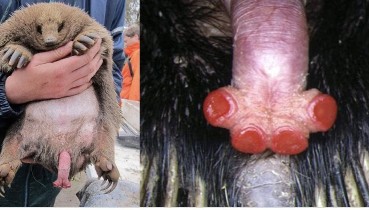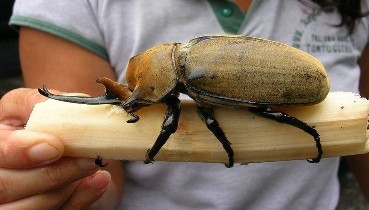Oregon beachgoers stumbled across a rare find over the weekend, after a deep-sea anglerfish washed up from the ocean depths.
The discovery marked the first time this creature, which typically dwells in the darkness up to 3,300ft below sea level, was seen on Oregon shores according to the local Seaside Aquarium, which posted about it on Facebook.With a gaping underbite that reveals its nightmarish spiny teeth, small black eyes, a tentacle-covered appendage and bulb protruding from its head, the finned creature may be recognizable to some as the monster from the deep in Pixar’s Finding Nemo.
The species is so rare that only a few dozen have been seen by humans since it was first discovered. “Little is known about their life history but what is known is unusually fascinating,” the aquarium wrote.
Rare and frightening footballfish washes up in California – again
Scientists say they typically lure unsuspecting prey into their mouths with the help from the flashy bioluminescent bulbs that dangle from their heads. They are covered in spikes and their sharp teeth are not used to chomp but to trap their food, which include other fish, squid and deep-sea crustaceans. But they aren’t terribly discerning when it comes to their diet: “They eat anything that can fit into their mouths,” according to the aquarium.
The so-called Pacific footballfish is one of more than 100 species of anglerfish found around the world. The specimen that was found, along with all the others that have been recovered since they were first identified more than a century ago, is female. The males of the species have evolved to become little more than sexual parasites that fuse themselves to their mates, losing all their internal organs, including their eyes, in the process. Connected forever, the male retains only his testicles to provide sperm in exchange for food. “How the males find the females in the pitch dark is still unknown,” the aquarium said.
Each footballfish that floats to the surface helps scientists piece together new information about the reclusive species. “We don’t know a lot about even the basics of how they live,”said Ben Frable, an ichthyologist and the collection manager of Fishes University of California San Diego’s Scripps Institution of Oceanography after that institution obtained one of its own, a female that measured roughly 15in and weighed 5.5lb in almost perfect condition. “Specimens like this, every time they wash up, can provide additional clues.”


 12 Things You Didn't Know About the Strange and Spiky Echidna1059 views
12 Things You Didn't Know About the Strange and Spiky Echidna1059 views Birds Of Paradise By Russian Artist Julia Gorina766 views
Birds Of Paradise By Russian Artist Julia Gorina766 views The 10 Most Unbelievable Places That Really Exist55223 views
The 10 Most Unbelievable Places That Really Exist55223 views 25 Photographs By This Prague-Based Artist That Are In Between Reality And Fiction1123 views
25 Photographs By This Prague-Based Artist That Are In Between Reality And Fiction1123 views 30 Wild Facts About the Boreal Forest89 views
30 Wild Facts About the Boreal Forest89 views 20+ Animals That Are So Big, It’s Hard to Believe They’re Real197 views
20+ Animals That Are So Big, It’s Hard to Believe They’re Real197 views The “Instagram Reality” Here Are 40 Of Their Best Posts..4063 views
The “Instagram Reality” Here Are 40 Of Their Best Posts..4063 views Photographer Captures the Otherworldly Beauty of the Arctic35 views
Photographer Captures the Otherworldly Beauty of the Arctic35 views


